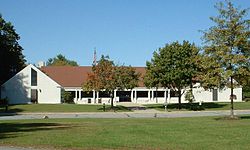Seekonk, Massachusetts
| Seekonk, Massachusetts | ||
|---|---|---|

Seekonk Town Hall
|
||
|
||
 Location in Bristol County in Massachusetts |
||
| Coordinates: 41°48′30″N 71°20′15″W / 41.80833°N 71.33750°WCoordinates: 41°48′30″N 71°20′15″W / 41.80833°N 71.33750°W | ||
| Country | United States | |
| State | Massachusetts | |
| County | Bristol | |
| Settled | 1636 | |
| Incorporated | 1812 | |
| Government | ||
| • Type | Open town meeting | |
| • Town Administrator | Shawn E. Cadime | |
| • Board of Selectmen | David J. Andrade Chairman Nelson Almeida Vice Chairman David F. Viera Clerk David S. Parker Michelle Hines |
|
| Area | ||
| • Total | 18.32 sq mi (47.7 km2) | |
| • Land | 18.22 sq mi (47.4 km2) | |
| • Water | 0.10 sq mi (0.3 km2) | |
| Elevation | 50 ft (15 m) | |
| Population (2010) | ||
| • Total | 13,722 | |
| • Density | 753.0/sq mi (288.0/km2) | |
| Time zone | Eastern (UTC-5) | |
| • Summer (DST) | Eastern (UTC-4) | |
| ZIP code | 02771 | |
| Area code(s) | 508 / 774 | |
| FIPS code | 25-60645 | |
| GNIS feature ID | 0618286 | |
| Website | http://www.seekonk-ma.gov | |
Seekonk is a town in Bristol County, Massachusetts, United States, on the Massachusetts border. It was incorporated in 1812 from the western half of Rehoboth. The population was 13,722 at the 2010 census. Until 1862, the town of Seekonk also included what is now the City of East Providence, Rhode Island. The land in the western half of the town was given to Rhode Island by the United States Supreme Court as part of a longstanding boundary dispute with Massachusetts.
The earliest known inhabitants of Seekonk were Native Americans from the Wampanoag Tribe. The name Wampanoag means People of the Morning Light. This name refers to the geographical area of the tribe. Living in the East they would be the first people to greet the sun each morning. The area now known as Seekonk and Rehoboth provided agricultural and water resources with abundant food supplies. During the warm summer months the Natives spent time near the rivers and oceans in what is now Southeastern Massachusetts. In the winter months the Natives lived inland, including several locations in Seekonk. At one time there were three Native American villages in the area we now call Seekonk.
There have been many spellings of the name Seekonk. Some of the various spellings include Seconch, Sink Hunk, Secquncke, Seaconke, and Squannakonk. The symbol of the goose in flight is used on the Town Seal.
The chief of the Wampanoags at the time the colonists settled in Southeastern Massachusetts was known as Massasoit or Ossamequin had been seriously affected by a plague just prior to the arrival of the Pilgrims at Plymouth. A large number of Wampanoag Indians had been killed by this illness. Most historians believe this plague to have been yellow fever.
...
Wikipedia

